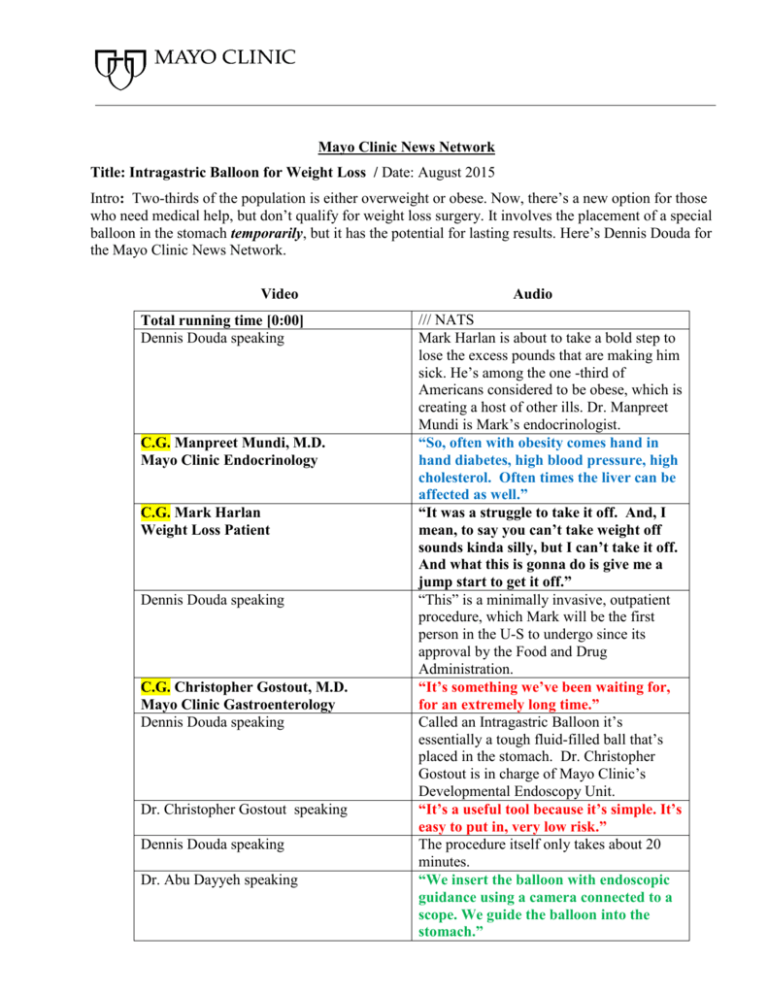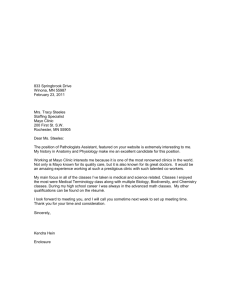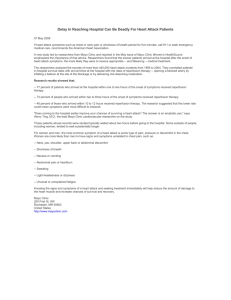Mayo Clinic News Network Title: Intragastric Balloon for Weight Loss
advertisement

Mayo Clinic News Network Title: Intragastric Balloon for Weight Loss / Date: August 2015 Intro: Two-thirds of the population is either overweight or obese. Now, there’s a new option for those who need medical help, but don’t qualify for weight loss surgery. It involves the placement of a special balloon in the stomach temporarily, but it has the potential for lasting results. Here’s Dennis Douda for the Mayo Clinic News Network. Video Total running time [0:00] Dennis Douda speaking C.G. Manpreet Mundi, M.D. Mayo Clinic Endocrinology C.G. Mark Harlan Weight Loss Patient Dennis Douda speaking C.G. Christopher Gostout, M.D. Mayo Clinic Gastroenterology Dennis Douda speaking Dr. Christopher Gostout speaking Dennis Douda speaking Dr. Abu Dayyeh speaking Audio /// NATS Mark Harlan is about to take a bold step to lose the excess pounds that are making him sick. He’s among the one -third of Americans considered to be obese, which is creating a host of other ills. Dr. Manpreet Mundi is Mark’s endocrinologist. “So, often with obesity comes hand in hand diabetes, high blood pressure, high cholesterol. Often times the liver can be affected as well.” “It was a struggle to take it off. And, I mean, to say you can’t take weight off sounds kinda silly, but I can’t take it off. And what this is gonna do is give me a jump start to get it off.” “This” is a minimally invasive, outpatient procedure, which Mark will be the first person in the U-S to undergo since its approval by the Food and Drug Administration. “It’s something we’ve been waiting for, for an extremely long time.” Called an Intragastric Balloon it’s essentially a tough fluid-filled ball that’s placed in the stomach. Dr. Christopher Gostout is in charge of Mayo Clinic’s Developmental Endoscopy Unit. “It’s a useful tool because it’s simple. It’s easy to put in, very low risk.” The procedure itself only takes about 20 minutes. “We insert the balloon with endoscopic guidance using a camera connected to a scope. We guide the balloon into the stomach.” C.G. Courtesy Orbera Dennis Douda speaking C.G. Barham Abu Dayyeh, M.D. Mayo Clinic Gastroenterology Dennis Douda speaking C.G. Karen Grothe, Ph.D. Mayo Clinic Psychiatry & Psychology Dennis Douda speaking Once we are in the stomach we start filling the balloon with a salt solution to the volume of about 600 milliliters.” Gastroenterologist Barham Abu Dayyeh says besides giving patients a sense of being full, it slows the rate food empties the stomach. After 6 months, the balloon is deflated and removed. In clinical trials, patients lost 3 times more weight than those using diet and exercise alone. “And the majority of weight that they lost at 6 months, the time the balloon comes out, was maintained at a year.” But, as with any weight loss procedure, Dr. Abu Dayyeh says the final results are greatly improved by a comprehensive, multidisciplinary team approach and patient education. “They have some level of awareness of portions, choices, level of activity; that’s what they’re going to need to be successful long term.” Mark’s goal is to lose 20% of his body weight and keep it for good. For the Mayo Clinic News Network, I’m Dennis Douda. Anchor tag: As for Mark, he’ll be on a liquid diet for a week or so and then begin eating soft foods. In 3 weeks he’ll be back on a normal diet, but restricted to 1000 calories a day. The balloon procedure is expected to be the most helpful to those with a Body Mass Index in the 30 to 40 range. [ ] For more information, visit our website at … [STATIONS: Per the licensing agreement, please provide a link from your station's website to http://www.MayoClinic.org or voice tag "MayoClinic.org" for more information.]







